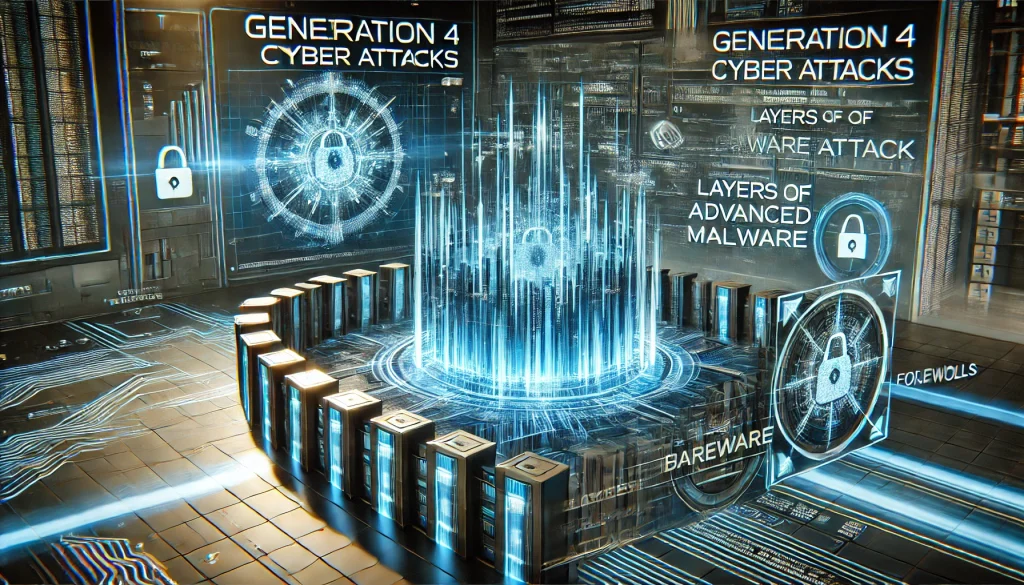
Overview
Cybersecurity has evolved tremendously, and today, businesses face increasingly sophisticated cyber attacks. One of the most dangerous types is the Gen 4 cyber attack. These attacks target not only systems but also manipulate vulnerabilities across networks, exploiting security loopholes in real-time. In October 2024, as cyber threats continue to rise, understanding Gen 4 attacks becomes critical. This type of cyber attack is particularly significant because of its ability to evade traditional security measures, leaving businesses vulnerable to data breaches, DDoS attacks, and even threats like the infamous Stuxnet worm.
With advancements in cybercrime, it is crucial to stay informed and proactive. This article will delve into the workings of Gen 4 cyber attacks, their impact on businesses, and how organizations can protect themselves from becoming the next victim of a devastating breach.
How Gen 4 Cyber Attacks Work?
Gen 4 cyber attacks represent a shift in how hackers approach security breaches. Unlike previous generations of attacks that focused on singular points of entry, Gen 4 cyber attacks are multi-vector. They combine various forms of attacks such as DDoS, social engineering, and phishing to infiltrate a network.
These attacks often involve advanced persistent threats (APTs), where hackers maintain access to a system for long periods to extract sensitive data slowly and stealthily. This type of attack typically bypasses conventional firewalls and antivirus software, exploiting zero-day vulnerabilities. Gen 4 cyber attacks often leverage automated tools to identify weak points in a network’s infrastructure.
Notable examples of Gen 4 cyber attacks include the attacks on Dyn in 2016, which crippled major internet services through a massive DDoS assault. The use of malware designed to adapt to the environment and remain undetected is a hallmark of Gen 4 attacks, making them particularly dangerous to businesses that rely heavily on digital infrastructure.
Examples of Gen 4 Cyber Attacks

One of the most significant examples of a Gen 4 cyber attack is the Stuxnet worm. This highly advanced piece of malware was designed to target specific industrial systems, mainly those controlling critical infrastructure. What made Stuxnet a Gen 4 attack was its ability to not only infect machines but also manipulate physical processes controlled by software. It caused significant damage to Iran’s nuclear program, demonstrating how cyber attacks can be weaponized to cause real-world harm.
Another notable example is the Dyn attack. In October 2016, a Gen 4 cyber attack took down much of the internet on the U.S. East Coast. This massive DDoS attack targeted Dyn, a company that manages domain name services (DNS), by flooding it with internet traffic from compromised IoT devices. This led to service outages for platforms like Twitter, Netflix, and PayPal, demonstrating the far-reaching impacts of such an attack.
Impact on Businesses
The impact of Gen 4 cyber attacks on businesses is profound and potentially catastrophic. These attacks go beyond simple data breaches and can disrupt entire operations, leading to financial loss, reputational damage, and in severe cases, legal consequences. In 2024, businesses are more interconnected than ever, relying on digital ecosystems for day-to-day operations. This interconnectedness, however, also increases vulnerability.
Gen 4 cyber attacks target not just IT infrastructure but also supply chains and third-party vendors, exploiting every possible weak link. As seen in the Dyn attack, businesses that rely on external services for critical operations can experience downtime, resulting in loss of revenue and consumer trust.
One of the most concerning aspects of Gen 4 attacks is their ability to stay undetected for long periods. Attackers can infiltrate a network, remain dormant, and then activate malware when it’s most damaging. The long-term presence of such threats inside a business’s network can lead to continuous data loss, intellectual property theft, and compromised customer data.
Prevention Strategies

Preventing Gen 4 cyber attacks requires a multi-layered approach. Businesses must implement both proactive and reactive strategies to defend against these sophisticated threats. The first line of defense is always employee training and awareness. Most Gen 4 cyber attacks begin with phishing or social engineering attempts, exploiting human error. By training staff to recognize these attempts, businesses can reduce the chances of a breach.
Another critical prevention method is the use of advanced threat detection systems. Unlike traditional antivirus software, these systems use AI and machine learning to identify patterns associated with malicious activity, even in zero-day threats. Regular updates and patches to software and systems are also essential to close vulnerabilities that attackers may exploit.
Moreover, businesses should adopt a zero-trust model, where no entity inside or outside the network is trusted by default. This limits the access of hackers who manage to breach one part of the system, preventing them from moving laterally across the network. Using encrypted connections, multi-factor authentication, and secure access controls are also vital in building a resilient cybersecurity infrastructure.
The Future of Gen 4 Cyber Attacks
The future of Gen 4 cyber attacks looks even more concerning as cybercriminals continue to develop new techniques to bypass security systems. With the rise of AI-powered attacks, businesses must stay one step ahead by adopting AI-powered defenses. Automation in cyber attacks means that hackers can deploy thousands of attempts to penetrate a system within seconds, making manual intervention nearly impossible.
Another emerging threat is the exploitation of the Internet of Things (IoT). As more devices become interconnected, the attack surface grows exponentially. IoT devices are often less secure than traditional IT infrastructure, providing a perfect entry point for cybercriminals. Securing these devices is critical to preventing future Gen 4 cyber attacks.
In the coming years, it is expected that businesses will face more attacks targeting cloud infrastructure, with hackers looking to disrupt services that are critical to business operations. As Gen 4 cyber attacks evolve, organizations must invest in cybersecurity tools that are equally dynamic and capable of adapting to these new challenges.
Conclusion
Gen 4 cyber attacks represent the next level of cyber threats, combining multiple methods of attack to breach even the most secure networks. With examples like the Dyn DDoS attack and the Stuxnet worm, it’s clear that businesses must stay vigilant and proactive in defending against these threats. The impact on businesses can be devastating, ranging from financial losses to irreparable reputational damage. Therefore, prevention strategies like employee training, advanced threat detection, and the adoption of zero-trust models are crucial.
In October 2024, the cybersecurity landscape is more challenging than ever. However, by staying informed and adopting a multi-layered security approach, businesses can protect themselves against the evolving threat of Gen 4 cyber attacks.
Key Takeaways
- Gen 4 cyber attacks are multi-vector, using a combination of methods like DDoS, phishing, and social engineering.
- Businesses must adopt AI-powered defenses and a zero-trust security model to combat these sophisticated attacks.
- Examples such as the Stuxnet worm and the Dyn DDoS attack highlight the far-reaching impacts of Gen 4 cyber attacks on both critical infrastructure and businesses.
Resources
- Check Firewalls. Preventing the Next Mega Cyber Attack.
- Cyber Magazine. History of Cybersecurity.
- KnowBe4. Five Generations of Cybercrime.
- Robotics Biz. Five Generations of Cyber Attacks in History.
- YU Katz School. The Evolution of Cyber Threats.
